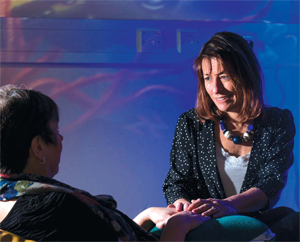Lesley Collier Talks About Sensory Rooms for Alzheimer's and Dementia
In 2010 there were an estimated 35.6 million people with dementia worldwide and this is set to double by 2030, according to Alzheimer’s Disease International (ADI).
Occupational Therapy research at Southampton has found that multi-sensory environments can help preserve cognitive and occupational behaviour.
New Boundaries talks to Dr Lesley Collier about her work.

Q What does your research involve?
The cognitive deterioration we see in people with Alzheimer’s disease and other dementias is not just due to the decline of the brain, it is also due to the environment around the person. We have found that by modifying the amounts of stimuli that people are bombarded with on a day-to-day basis and adjusting the sensory input to meet sensory need, Alzheimer’s symptoms can appear less. Multi-sensory rooms have traditionally been used for people with learning difficulties as a leisure activity; however they are now used extensively for people with dementia. By using a tool box of equipment that stimulates the senses of sight, sound, taste, smell and movement, the rooms can provide a large variety of activities that aid concentration and provide stimulation or relaxation dependent on sensory need. We are using the rooms to modify the level of sensory stimulation a person receives – limiting the large amounts of stimuli that people with Alzheimer’s disease have to deal with, so that it is easier for them to concentrate on simple tasks.
Q Why is this area of research important?
With improvements in health care over the last century, people are living longer; the ADI estimates that 7.7 million new cases of dementia are diagnosed each year. Also it is acknowledged that it is hard to engage people who have moderate to severe dementia in conventional activity. Our work focuses on working with people with dementia to try and reduce their symptoms by allowing them to practice everyday tasks in a controlled, sensory stimulation environment.
Q What is the impact of your research on society?
The first time we observed a person with dementia in a multi-sensory room, we noticed he became more focused, would pick up equipment, smile and vocalise, and then move on. This was very different from the behaviour he exhibited normally; aggression and the inability to settle to any activity. Following this very early study, we collaborated with Rompa, the company that produces the Snoezelen room, a type of multi-sensory environment for use in hospitals, homes, schools, therapy centres and care homes and they provided us with equipment to develop this area of research. My most recent research study has been looking at increasing a patient’s independence in functional performance – how they use a knife and fork to eat independently or put on their shoes. We have found that when people spend time in a structured multi-sensory room and then carry out activities of daily living, they are more able to do it and make less performance errors than if they were left to try and complete the activity alone. As a result of our work, the National institute for Health and Clinical Excellence (NICE) guidelines recommend the use of multisensory activities with people with dementia.
Q What is the global impact of your work?
A large proportion of my time is spent working with health care providers around the world in order to introduce multi-sensory environments into their treatment regimes for people with dementia. For example, I have worked with representatives of the royal family in Saudi Arabia, Hong Kong’s health department and the ministries of health in Thailand, Malaysia, Brunei and Singapore to establish treatment regimes in each country. I also work with therapists in these different countries to highlight cultural differences so that multi-sensory treatments can be adapted for maximum benefit to the patient.
Q What sparked your interest in this topic?
Before joining the Health Sciences, I was a clinical Occupational Therapist. My colleagues and I found it very challenging to engage people with severe dementia in activities. As a result, I worked with a psychologist looking at ways we could reach these individuals and we heard about the use of multi-sensory activity at a local children’s centre. This led us to try a multi-sensory approach with some of our patients before instigating the first piece of research in this field in the UK.
Q Is multidisciplinary collaboration important in your research?
Working as part of a multidisciplinary team is essential for this type of work. As such, multi-sensory approaches are now part of the Occupational Therapy and Physiotherapy curriculum within the Health Sciences. Also the close working relationship I have with the researchers in the Institute of Sound and Vibration and Ship Science has also allowed me to further develop my sensory work with other client groups. For example, with the Royal National Lifeboat Institution (RNLI), we are working to decrease the amount of stimuli on vessels to reduce confusion in emergency situations.
Q Why is Southampton a good place to do your research?
It is important to me that my research is translated into practice. The Occupational Therapy programme at Southampton is recognised as being at the forefront of Occupational Therapy and is acknowledged as pioneering evidence-based interventions. As such, Southampton is a prime location to move multi-sensory research into practice.
Q What is your next project?
Understanding how sensory stimulation effects occupational performance is a compelling question and I would like to further explore how specific sensory input influences performance. What I would like to do next is to monitor the brain activity while a person with dementia is using the multisensory room. This would give us a greater understanding of how the different sesnory activities stimulate the brain.
First Published NewBounderies | June 2013 | University of Southampton




